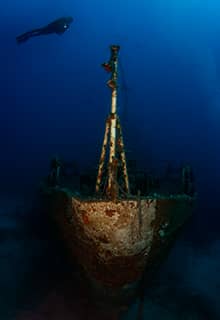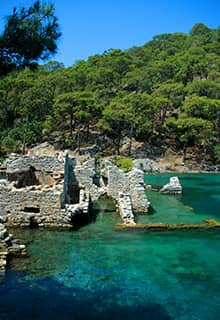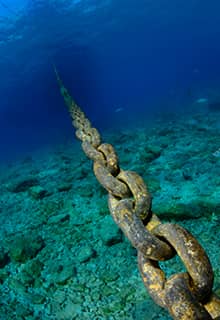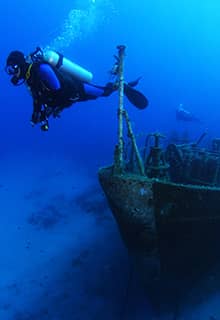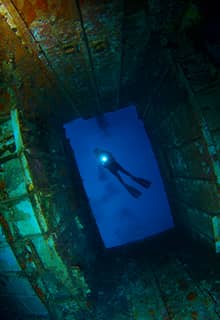Aegean
Türkiye
Bodrum
There are several unique bays around the Bodrum Peninsula. The seas swiftly change from shallow to astonishingly deep with an abundance of fishes, octopuses, seaweed, seagrasses, and sea sponges.
There are around 20 dive sites off the Bodrum Peninsula featuring two shipwrecks, a plane, walls, caverns, and pinnacles. With dive depths up to 30 meters, you will be well-placed to see the likes of stingrays, barracudas, tunas, moray eels, and octopuses.
In Bodrum’s underwater world, you’ll come across a big and a small reef. These two reefs between Bodrum and Kara Ada (Black Island) are separated by only 200 meters. The reef walls are packed with marine life and extend from 5 m all the way down to 32 m on the south side and 36 m on the north.
From Wolf's Point to Kargı Adası (Kargı Island), dive sites offer something for everyone, including a 29-meter shipwreck of the SG115 cargo ship; Pınar 1, a 37-meter former Turkish Navy water tanker; and the Douglas C-47 Skytrain or Dakota plane, an ex-Turkish Air Force parachute airplane that was sunk to create an artificial reef.
In fact, it was during a sponge diving expedition when a local stumbled upon the wreck of the Uluburun, a Bronze Age vessel dating back to 1400 BC. Now, the shipwreck is on display at the Bodrum Museum of Underwater Archaeology.
Datça
Datça is a beautiful area with hot springs, glorious coves, and beaches. It is also a key marine center as it is the most important nesting site in Türkiye for loggerhead sea turtles (Caretta carettas). Tha Datça Peninsula boasts many beautiful coves and areas for snorkeling and diving, with dolphins, sharks, and other marine life spotted regularly in the region. Datça promises diving enthusiasts many unforgettable underwater experiences!
Marmaris
The underwater world of Marmaris is very attractive, offering excellent visibility and many dive sites in well-protected bays – perfect for some gentle, stress-free holiday diving! Both shore and boat diving are available, and larger centers offer a range of courses and night dives. As with the diving around Bodrum, expect a variety of sites from caverns to reefs and plenty of opportunities to spot some of Türkiye’s ancient amphoras.
Kadırga Cove is one of the most popular diving spots in Marmaris. This site could be renamed “Amphoras and Eels”- such is the prevalence of both at this dive. Opposite the Kadirga Lighthouse and stretching down some 40 meters, this rocky site is suitable for most levels of diving experience. Other than the field of amphoras, at a depth of 15 meters, the remains of a ship from the Hellenistic period also await divers.
Fethiye
The sea floor of Fethiye is made up of swim-through arches coated in soft corals, mysterious tunnels, and plunging slopes!
Red Island in Fethiye is a natural amphitheater measuring 20 meters. Head here at night with a torch to reveal a plethora of vivid sponge. Investigate the engine bays of the 40-meter-long TSCG (Turkish Coast Guard) ship that sits 27 meters below land.
Aquarium Bay, one of the best diving sites in Türkiye, near Fethiye, became a protected site in recent years. It is a suitable diving site for both less experienced and more advanced divers. Aquarium Bay is also a great spot for night diving.
Don’t leave Fethiye before diving in Aladdin’s Cave! This unique dive takes you to a cavern at 29 m where divers can view delicate colorful corals and the resident grouper. After a few minutes you ascend to 12 m and then fin to another cavern known as the “hammam” where natural light falls through two openings in the ceiling.
Çeşme (İzmir)
Çeşme offers a clarity of water very rarely found and a diverse range of marine species. Dive sites include the Bedroom, a spectacular cave particularly loved by underwater photographers, and Split Rock at Eşek Island where experienced divers can go down 45 meters.
Suitable for all divers, Fener Island is in northeast of Çeşme, in İzmir’s popular holiday spot. Fener Island is a great spot for those seeking an underwater adventure in a colorful site that extends 18 meters below water.
At Fener Island, you can swim with streams of sargos (or white seabreams) and breams surrounded by yellow marine sponges and coral flowers. In an old seal cave, you can even come across some seals!
Kuşadası & Didim (Aydın)
Kuşadası, a popular holiday spot on Türkiye’s Aegean coast, has one of the more unusual dive sites in the form of an A300 Airbus. With a 44-meter wingspan and a length of 54 meters, the local council sank the 36-year-old aircraft to attract international divers. Perhaps, the highlight of the dive is a flight through the interior of the A300 to visit the cockpit. The fittings, cables, and switches have all been removed but it’s a unique feeling to sit in one of the cockpit seats and to look beyond, into the impenetrable blue of the Mediterranean.
The Aegean underwater world around Didim creates amazing opportunities to explore marine life and the chance to explore a deliberately sunken former coastal guard ship.
Ayvalık (Balıkesir)
Ayvalık, a beautiful location on the north Aegean coast, has a variety of diving spots and islands, making it a popular spot for divers. Deli Mehmet is one of the best diving spots in Ayvalık with two underwater islands. One of them, Deli Mehmet 1, is 18-70 meters deep and favored by intermediate divers. The second island, Deli Mehmet 2, is 27-70 meters deep. Unlike Deli Mehmet 1, this is preferred by professional divers. There are stunning coral reefs from 27 meters up to 50 meters. You can see the red corals on each island, and swim with moray eels and a variety of colorful fish.
In addition to Deli Mehmet, İlyosta Island is another popular and beautiful diving spot of Ayvalık. İlyosta is a lively, vibrant spot with plenty of sea creatures – once you dive, you will find yourself surrounded by them and you can photograph them to your heart’s content.
Gavur Port is the most popular diving site on İlyosta Island. It extends between 3 and 35 meters, and is suitable for both experienced and inexperienced divers. You can observe many great underwater creatures here: aquatic insects, moray eels, and even sea bunnies (Jorunna parva), so don’t forget to take a flashlight with you.
Saros Bay (Çanakkale)
Its underwater treasures make Saros Bay a prominent diving spot on the northern Aegean coast of Türkiye.
Saros Bay has strong sea currents and is untouched by the effects of large urbanization and industrialization. As a result, it is one of the cleanest, purest parts of the Aegean Sea. The bay self-cleans three times a year: it rids itself of waste through currents and the mixture of warm and cold water.
There are over 200 different sea species in the bay such as aquatic insects, lobsters, starfish, and sea snails. You’ll also find a large number of diving sites here: İbrice Port, Cennet, Cehennem, Toplar Burnu, Asker Taşı, Üç Adalar, Kömür Harbor, Bebek, and Minnoş Kayalıkları. Minnoş Kayalıkları is the most well-known site among them. Approximately 15 meters beneath sea level, the cliffs have colorful rocks. After the first few meters, you can see the dolphins and sea turtles, and swim past orange corals. At the end of the cliff, you may encounter anglerfish and huge stingrays.
Saroz Bay is also home to shipwrecks. One of them is the Lundy shipwreck that weighs 188 tons. The ship was built in 1908 and sunk in 1915. The shipwreck is located at Suvla Bay, south of Saros Bay. The ship’s silhouette appears after 13 meters and after 18 meters you can walk around the captain’s hull and watch the bream swim around the deck. Where the ship meets the sand, you can find lots of lobsters and leerfish.
The latest wreck at Saros Bay in the Airbus A330, which was sunk in March 2019, and has been available for viewing since summer 2019.
Gallipoli (Çanakkale)
At the meeting point of the Aegean and Marmara Seas, Gallipoli is on the Dardanelles Strait, close to Çanakkale, and is positively teeming with marine life and fascinating shipwrecks.
The Gallipoli Peninsula is the site of a World War I battle between the English forces and their allies, and the Turks. Highlights include the wreck of the cargo ship Lundy, which was hit and sunk by a torpedo on April 15, 1915, and the HMS Majestic, which lies 18-28 m below sea level.
There are 216 shipwrecks in and around the Gallipoli Peninsula and Çanakkale. These wrecks cover a large variety of sea vessels except for galleons. Dive depths range from 7 to 30 meters. Normal dive to static line dives can be undertaken. The Milo was partially sunk by the allies in October 1915 to create a water-break to protect the Australian and New Zealand Army Corps (ANZAC) in their efforts to harbor at North Beach. It was broken in two by a storm on November 18, 1915 and now lies only 15 cm from its original position. The wreck, which is situated off the shore of North Beach at the ANZAC site, is an underwater testimony to the strength and endurance of the men of Gallipoli.
